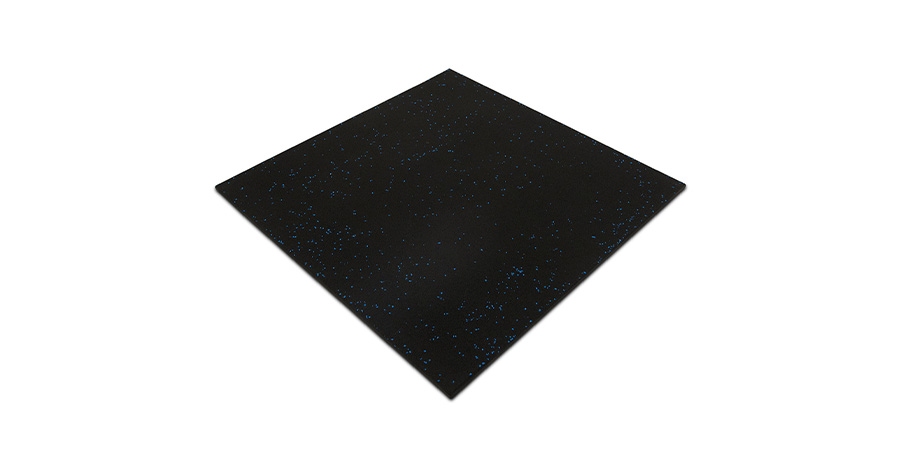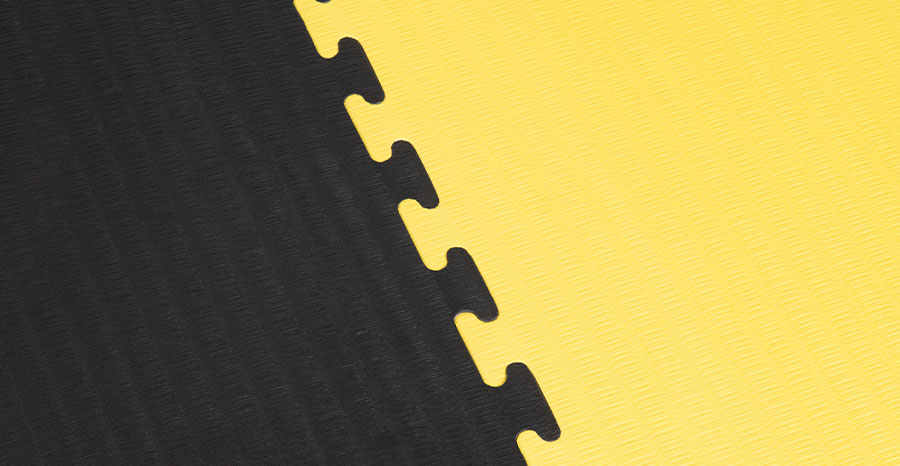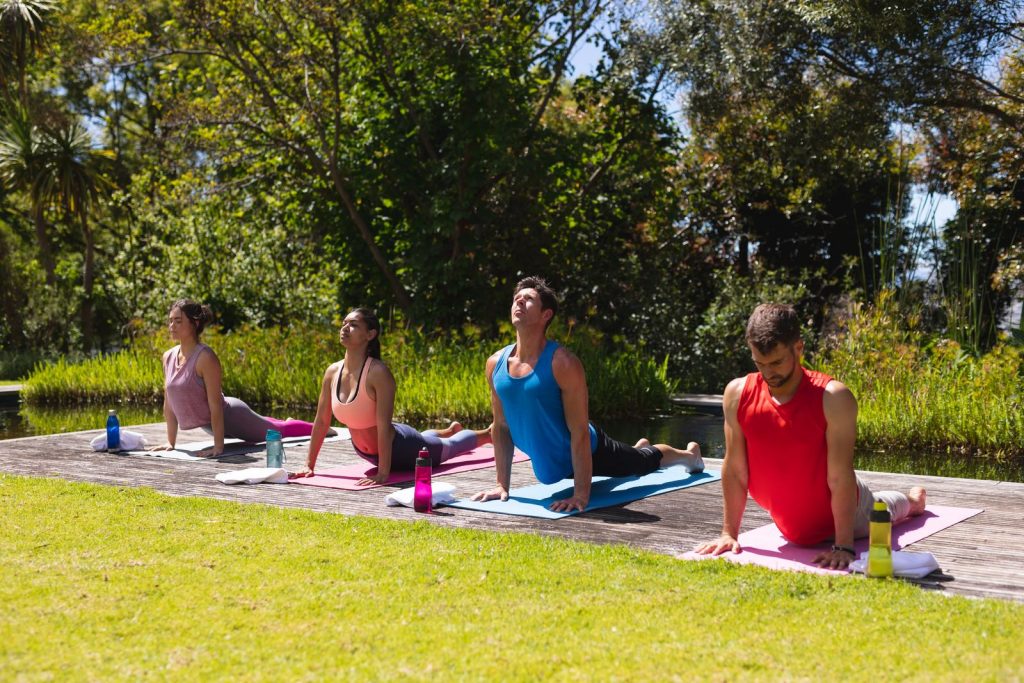
Choosing the Right Gym Mats & Flooring for Optimal Workouts
Has your latest workout been a literal pain? We’re talking bruises, slipped discs, or even just that nagging ache that tells you something’s off? You’re giving it your all, but the hard, unyielding floor beneath you isn’t giving anything back. Let’s face it – your workouts deserve better. They deserve gym mats.
Imagine going from gritty concrete or a hardwood floor to a soft, supportive surface that cushions your every move. Sounds dreamy, no? Well, the right gym mat flooring does exactly that. It takes the pressure off your joints, absorbs the impact of your workouts, and helps you train safely and effectively.
But, how do you choose the right gym mats for flooring? You need something that matches your fitness goals, fits your space, and doesn’t break the bank. It’s a lot to navigate, we get it.
We’ve put together a comprehensive guide to help you pick the perfect gym mat flooring. So you can focus on what matters most.
What Are Gym Mats?
Gym mats, or exercise mats, are specially designed flooring solutions that offer a soft and supportive surface for your workouts. Durable gym floor mats cushion the impact of your exercises, protect your joints, and provide a non-slip surface that keeps you safe as you sweat. The best part? They’re versatile and can be used for a variety of activities.
Whether you’re a yogi finding zen in your sun salutations, a fitness fanatic crushing your cardio sessions, a weightlifter pumping iron, or a gymnast perfecting your routine, there’s a gym mat for you. Different exercises have different demands. And gym mats cater to these by varying in thickness, material, and design.
The Importance of Proper Gym Mats Flooring
Safety first, isn’t it what they say? Well, in the domain of fitness, the old adage rings exceptionally true. And a key player in keeping your workouts safe and injury-free is proper gym mat flooring.
One of the critical roles of gym mats is absorbing the shock of your movements. Every jump, squat, and burpee sends a jolt of force through your body. Without the right cushioning, this force can strain your joints and lead to injuries. But with the right gym mat, this impact is softened, decreasing the risk of injuries and keeping you in the game longer.
But it’s not all about playing defense. Having the right gym mat flooring can actually amp up your workout performance. Ever tried holding a plank on a slippery surface? It’s a workout for your patience more than your muscles. A good gym mat gives you a stable, grippy surface that lets you focus on your form and get the most out of every rep.
Let’s not forget about comfort. A well-padded mat can make the difference between an invigorating workout and a literal pain in the neck (or back, or knee…). So, investing in high-quality gym mat flooring is a game-changer.
Different Types of Commercial Gym or Home Gym Flooring
Choosing the right flooring for your gym – whether it’s a commercial space or a cozy corner in your home gym – can feel a bit like being a kid in a candy store. So many options, each with its own pros and cons.
So let’s cut through the noise and focus on the three heavy-hitters: rubber, foam, and PVC.
Rubber Gym Flooring
Rubber is the Arnold Schwarzenegger of gym flooring. It’s durable, resilient, and can take a beating from heavyweights. The high-density structure of rubber flooring provides excellent shock absorption, making it perfect for weightlifting or high-impact workouts.

Pros of Rubber Gym Flooring
- Exceptional durability: Commercial rubber gym flooring stands up well to heavy weights and rigorous use.
- Excellent shock absorption: Offers solid protection for your joints during high-impact workouts.
- Easy to maintain: Just sweep or mop it clean; it’s as simple as that.
Cons of Rubber Gym Flooring
- Heavy-duty and non-portable: Not the best choice if you need to move your workout area around.
- Higher cost: Quality comes at a price, and rubber is generally more expensive than foam or PVC.
- Potentially strong odor: New rubber mats can emit a strong smell, though it usually fades over time.
Foam Gym Flooring
On the flip side, foam is your friendly neighborhood yoga instructor. It’s soft, comfortable, and great for low-impact exercises like yoga or Pilates. Additionally, it’s lightweight and often comes in interlocking tiles for easy flooring installation.
Pros of Foam Gym Flooring
- High comfort: Offers a soft surface, perfect for floor-based exercises.
- Lightweight: Easy to install, remove, or reconfigure as per your needs.
- Affordable: Foam mats are generally more budget-friendly.
Cons of Foam Gym Flooring
- Not suitable for heavy weights: Foam can compress under heavy loads.
- Lower durability: May show wear and tear sooner than rubber or PVC.
- Cleaning challenges: Foam can absorb moisture, making it harder to clean and maintain.
Jigsaw Mats (Interlocking Mats)
Jigsaw mats, also known as interlocking mats, are a clever solution for those who require flexibility and ease of installation. Made from EVA foam or rubber, these mats interlock like puzzle pieces, creating a secure yet adjustable floor covering that’s easy to put together or pack away.

Pros of Jigsaw Mats
- Versatile: Suitable for various activities from martial arts to yoga, providing ample shock absorption.
- Easy to install: The interlocking design allows for a simple and quick setup.
- Adjustable size: You can add or remove pieces according to your space requirements.
Cons of Jigsaw Mats
- Variable durability: While rubber versions are sturdy, EVA foam ones may not stand up to heavy weights or high-intensity workouts.
- Maintenance: Gaps between the tiles can trap dirt or sweat, requiring more thorough cleaning.
PVC (Vinyl) Gym Flooring
PVC, or vinyl flooring, is a versatile all-rounder. It combines the durability of rubber with the comfort of foam, making it a popular choice for a variety of workout spaces.
Pros of PVC Gym Flooring
- High versatility: Tough, water-resistant, and suitable for a variety of workouts.
- Easy to clean: Its water-resistant nature makes cleaning a breeze.
- Durable: Offers a balance between comfort and durability.
Cons of PVC Gym Flooring
- Less cushioning: While it’s more comfortable than rubber, it doesn’t match the softness of foam.
- Potential for slipperiness: It can be less grippy than rubber, especially when wet.
- Slightly pricier: More affordable than rubber but pricier than foam.
How to Choose the Right Gym Mats Flooring for Your Specific Needs
Choosing gym flooring options isn’t a one-size-fits-all deal. It’s about finding the perfect fit for your workout style, location, and other specific needs. Sounds complex? Don’t sweat it! Here’s a straightforward guide to help you navigate the gym mats and flooring.
Understand Your Workout Type
The type of exercise you primarily engage in sets the stage for your gym mat selection. Love yoga or Pilates? A softer yoga mat, such as foam, that offers comfort and cushioning, should be your go-to. On the other hand, if you’re into high-impact workouts or weightlifting, you’d want something denser like rubber gym mats or PVC. These materials are built to withstand the hard-hitting, repetitive nature of these workouts.
Indoor vs. Outdoor Workout
Your workout location also plays a big role in your decision. If you’re creating an indoor gymnastic, all three types – gym rubber flooring, foam, or jigsaw mats could work well. But, if you’re planning outdoor use, weather resistance becomes a crucial factor. PVC fitness mats steal the show here due to their durability and water resistance.

Size, Thickness, and Durability
Consider the size of your gym mat. Measure your workout area to ensure you purchase a mat that fits just right. Too small, and you risk stepping off during your workout; too large, and it becomes an inconvenience.
Thickness is another crucial factor. More intense workouts need thicker mats to protect your body from the hard floor. However, balance-intensive workouts like yoga may require a thinner mat for stability.
Lastly, durability should be a key consideration. Especially if you’re running a commercial gym or training heavily. While foam mats might be economical, they may not stand the test of time like their rubber or PVC counterparts.
Step-By-Step Installation Guide for Gym Mats Flooring
Transforming your workout space with gym mat flooring can be as satisfying as nailing a new personal best. But if not done right, it can quickly turn into a workout in frustration. To help you avoid common pitfalls and get the job done efficiently, here’s a handy step-by-step installation guide.
Step 1: Preparing the Area
The first step is to clean the area where you’ll install your gym mat. Sweep or vacuum to get rid of any dust or debris that could interfere with the installation process. Ensure the surface is dry and flat.
Step 2: Measure Twice, Cut Once
Take accurate measurements of the area to ensure your gym mat fits perfectly. Remember, it’s always better to have a slightly larger mat that you can trim down, rather than a mat that’s too small.
Step 3: Lay the Mat
Start laying your mat from one corner of the room and work your way across. If you’re using interlocking gym tiles, match the locks and press them together firmly until they click into place. For roll mats, simply roll them out, ensuring they lay flat against the surface.
Step 4: Trim the Excess
If your mat is slightly larger than your space, use a utility knife to trim the excess. Make sure to use a straight edge as a guide for a neat finish.
Step 5: Seal the Seams
For an extra touch of professionalism, use a seaming compound to seal the seams between interlocking tiles. This will give your flooring a smooth finish and keep it from coming apart during intense workouts.
Common Mistakes to Avoid
Avoid these common pitfalls to make the most of your gym mats:
- Not letting the mats acclimatize: Gym mats need to breathe. Leave them in the room where they’ll be installed for 24 hours before starting the installation. This allows them to acclimate to the temperature and humidity levels and prevents future warping.
- Neglecting subfloor prep: A clean, flat subfloor is essential for a successful installation. Neglecting this step can lead to uneven flooring or damage to the gym mats.
- Skimping on measurements: Accurate measurements are crucial. A mat that’s too small will move around during your workout, and one that’s too big will need constant adjustment.
Cleaning Solution for Home or Commercial Gym Flooring Mats
As the saying goes, “Cleanliness is next to godliness,” and this applies to gym mats too. Sweat, dust, and dirt can build up over time, making your mat less effective and possibly even a breeding ground for bacteria.
Here’s a simple routine to keep your gym mat sparkling clean:
- Daily Sweeping or Vacuuming: A quick sweep or vacuum removes surface dust and debris. Just make sure to use a soft brush attachment to prevent damage.
- Weekly Deep Clean: Mix a mild detergent with warm water and use a soft cloth to wipe down your mat. Avoid soaking the mat and ensure it’s thoroughly dry before using it again.
- Spot Cleaning: Spilled some pre-workout shake? No problem. Simply wipe the area with a cloth soaked in soapy water, rinse with a damp cloth, and dry.
Maintaining Different Types of Gym Mats (Yoga Mats, Jigsaw Mats)
Different types of mats require slightly different care:
- Rubber Mats: These tough guys are relatively low maintenance. However, they can be sensitive to certain cleaning chemicals, so stick to a mild detergent and avoid using oil-based soaps or harsh chemicals.
- Foam Mats: They’re soft and comfy but can be a bit delicate. Never use abrasive brushes or harsh cleaners on foam mats. And remember, they’re not fans of the sun, so keep them away from direct sunlight to prevent warping and fading.
- PVC Mats: PVC mats are durable and easy to clean. Feel free to use a mild detergent for regular cleaning. Just remember to dry them thoroughly – while they’re water-resistant, they’re not waterproof!
- Jigsaw Mats: Often made from EVA foam, jigsaw mats are another common choice for gym flooring due to their interlocking design and durability. However, they have their own cleaning considerations. Use a soft cloth or mop with mild detergent for general cleaning. Avoid using hard-bristled brushes or strong chemicals that could damage the foam. Also, while jigsaw mats are resistant to moisture, they are not entirely waterproof. Be sure to dry them thoroughly to prevent moisture build-up and bacterial growth.
Read out a detailed guide on The Dos and Don’ts of Gym Equipment Maintenance
Shop Premium Grade Gym Mats from Dynamo Fitness Australia
All of this talk about gym mats probably has you itching to upgrade your workout space, right? Well, you’re in luck!
We invite you to visit our Dynamo Fitness stores located in Melbourne, Sydney, and Perth. You’ll be able to personally explore our extensive collection of top-tier gym mats. Experience the comfort and resilience of our products firsthand, and take advantage of our friendly staff’s expertise.
If you’re unable to visit in person, no worries! You can still experience the top-quality range we offer by visiting Dynamo Fitness Equipment online. Our website is stacked with a wide range of gym mats and other gym equipment, ready for you to browse at your convenience. We deliver your gym equipment right to your doorstep Australia-wide.
At Dynamo Fitness, we’re all about supporting your fitness journey, every step, rep, and breath of the way. Don’t forget to check out our buy now and pay later offer. Contact us know if you have any queries.
